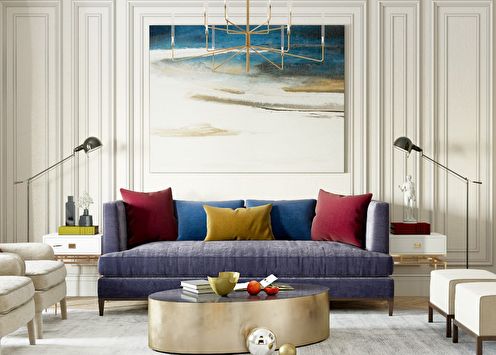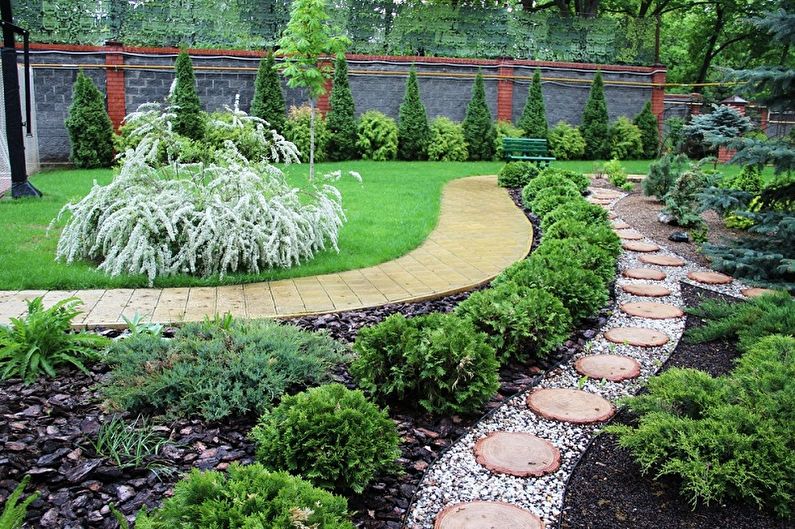
For most people, the summer cottage has ceased to personify a place with endless beds, on which you need to work tirelessly for almost the entire summer. Now a suburban area is a territory for relaxation and aesthetic pleasure. Ensuring a harmonious unity of man with nature will help landscape design. About great ideas for the garden - in our article.
Features of landscape design
Landscaping is at the crossroads of construction, architecture and crop production. For proper landscape design, it is also necessary to have certain information about the style directions and the rules of harmony of forms.
Landscape decoration is a real art that professionals have been doing for centuries. However, if you want to independently transform the territory of the cottage, you just need to familiarize yourself with the basics of planning and ready-made projects in order to put into practice those ideas that you like.
So, before starting work, pay attention to the following points:
- to transform the site are used as objects of living and inanimate nature, and objects created by man, with each of them must fit into the overall composition;
- it is necessary to look after the finished garden, therefore, if you can not regularly devote time to this, stop at simple solutions;
- think over the main idea and work plan, create a basic scheme, and add decorative elements to it;
- not every project can be put into practice. Consider the quality of the soil and the degree of illumination - each plant requires special conditions for normal development.
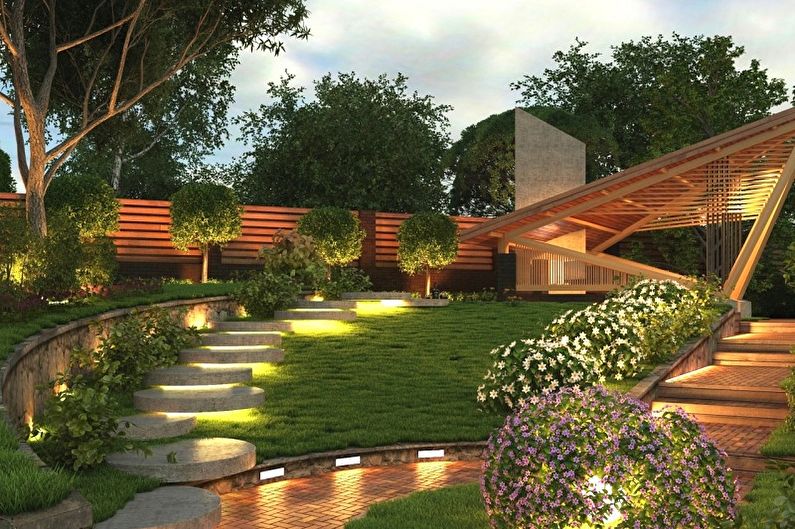
Styles
It is easiest to work on one topic, which will determine the geometry of the location of landings. Please note that her choice is influenced by the architecture of the buildings.
Classic style
The traditional-style garden is also called regular. First of all, it is characterized by a consistent order and symmetry. Ideally, the direction is embodied in country estates with a vast territory, but it is quite possible to implement such projects in small open spaces of a summer residence.
Plant shrubs and trees with a dense crown, which later can be given the right shape. Take care of them and trim them in a timely manner. Lay paths straight, and arrange flower beds, alleys, lawns, ponds and stalls in geometric configurations (polygons, ovals and circles are suitable).
Classic requires the selection of natural materials and the implementation of other buildings in a similar direction. The color palette is restrained, basic shades will do. You can complement the design with a fountain in the center of the composition, topiary plants, as well as beautiful sculptures in the antique style.
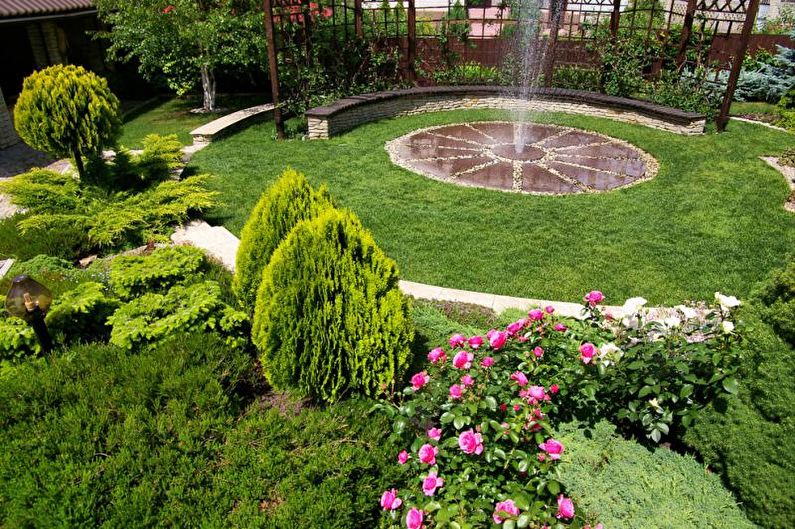
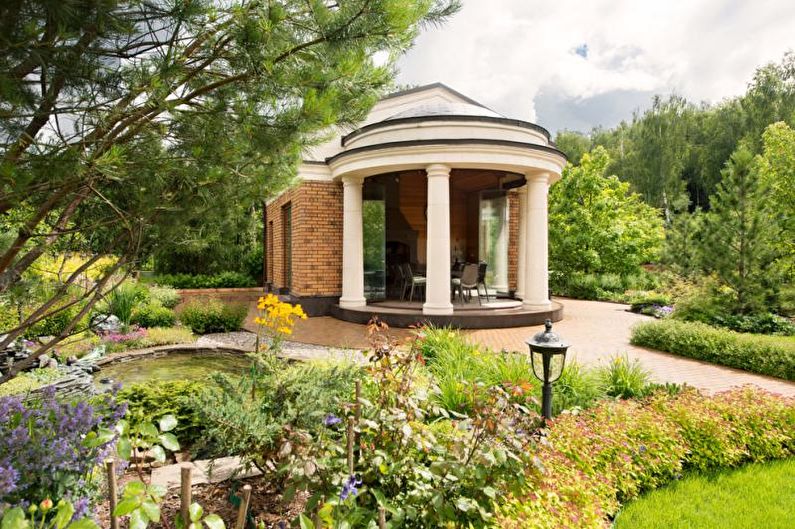
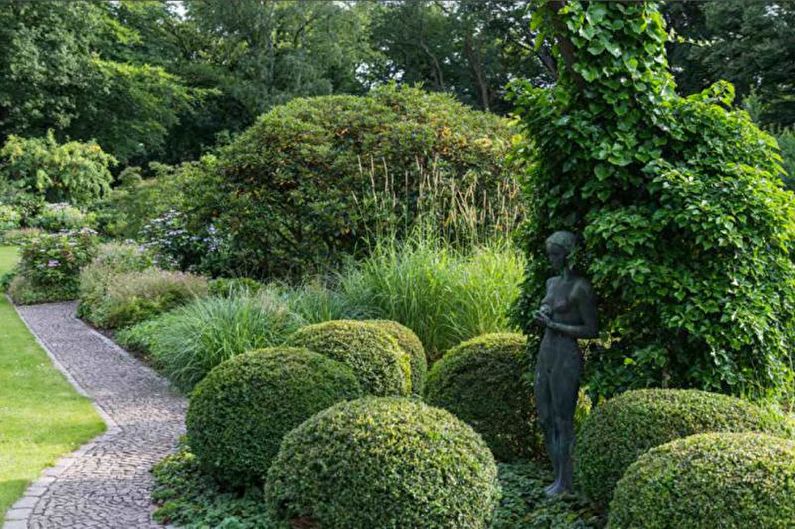
Country style
The simplicity and comfort of the village front gardens and gardens look cute and relaxed. It is this direction that has been familiar to mankind since time immemorial, when all representatives of society lived in ingenuous houses with modest but neat lawns.
For country, the following elements are characteristic:
- fruit trees, vegetable beds;
- lush flower beds of free design;
- trails of wood saw cuts, stone, gravel, the usual earthy options;
- decorative parts made by hand;
- wooden arbors and benches surrounded by vegetation;
- a small reservoir of a natural form;
- a combination of natural colors with colorful and cheerful shades.
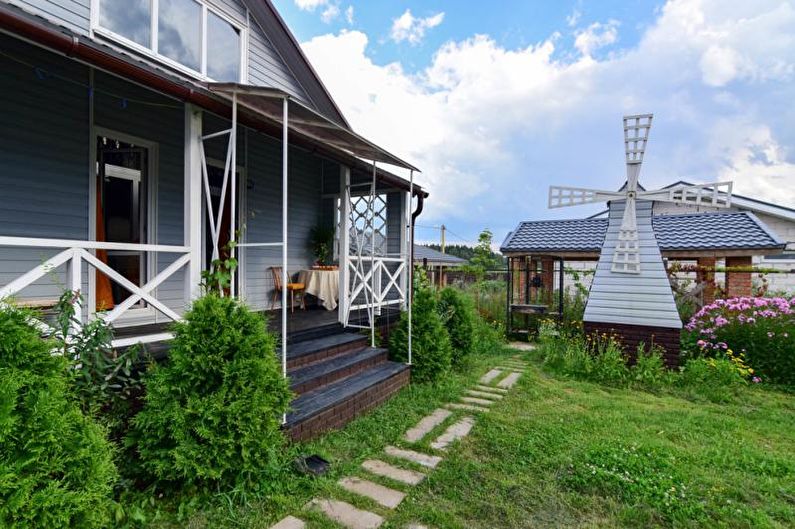

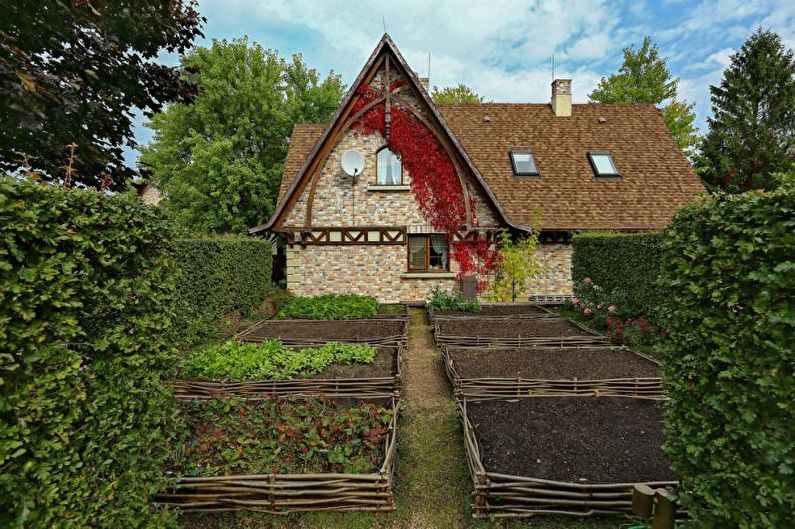
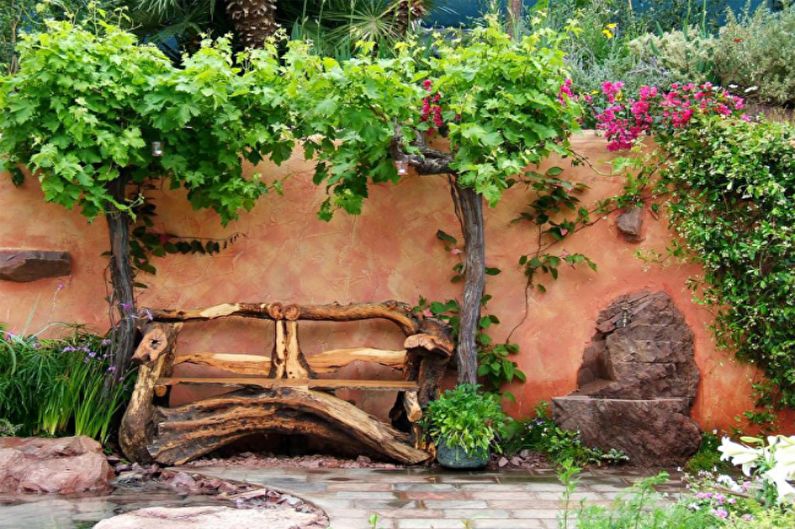
Eco style
The trend direction softens the contradictions between the technogenic environment and natural motives. The purpose of the eco-garden is to recreate a wildlife zone in a private area. Therefore, the main rule is naturalness and ease, use:
- natural materials;
- cultivars along with field, forest plants;
- canopies and huts;
- wood bridges, benches, hemp and saw cuts;
- creative crafts and lamps;
- garden furniture of rough configurations.
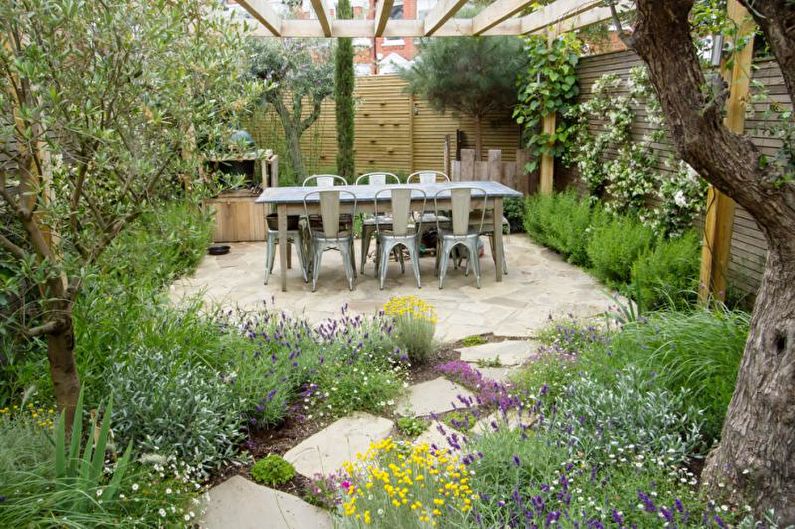

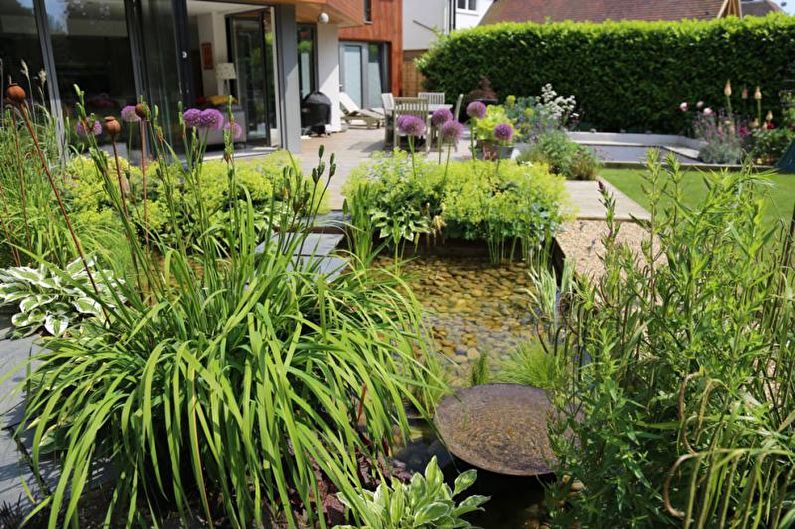
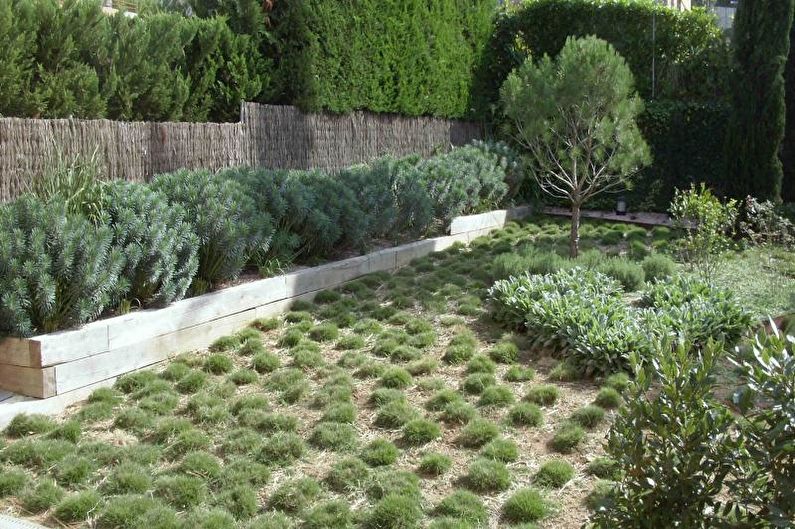
Japanese style
Somewhat exotic current for our open spaces. It requires appropriate minimalist decoration for buildings, which is not always typical for summer houses. Nevertheless, individual motives can quite organically lie on a standard basis.
To organize a garden with features of the Japanese tradition, use:
- streams, bowls with water, small lakes;
- stone gardens with pebbles;
- light, asymmetric open spaces, conducive to contemplation;
- low conifers, moss, sand;
- bamboo hedges;
- combined paving;
- seasoned color scheme (black, white, sand, green, brown, gray);
- The main attention is paid to harmony, naturalness.
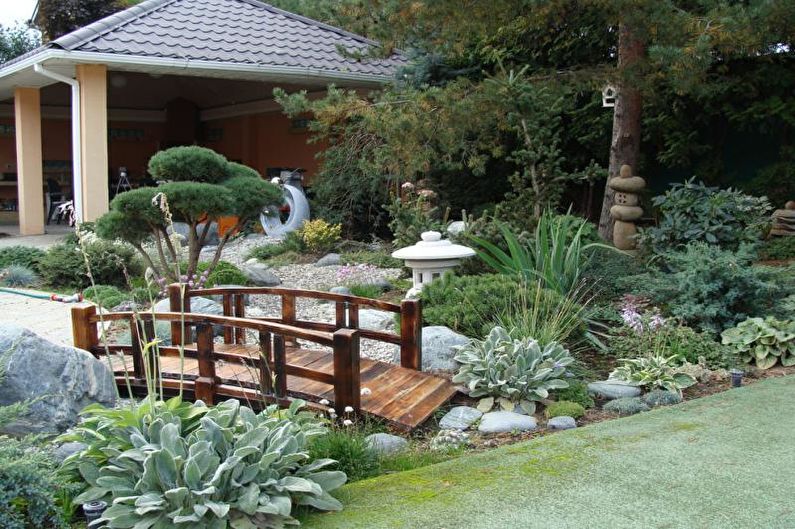
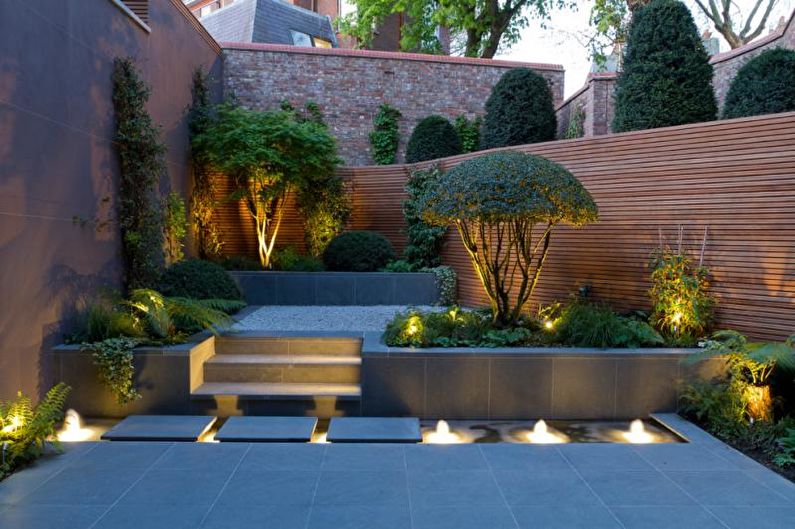
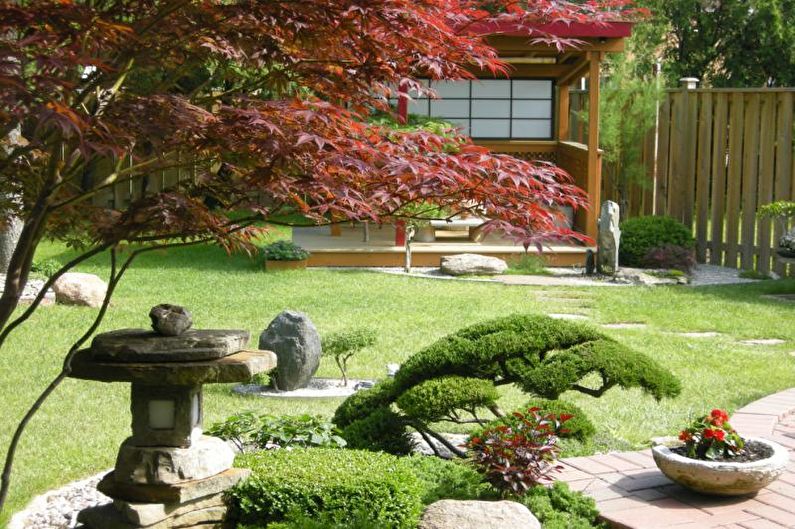
Minimalism
Minimalist style came from interior design. It stands on the same basis - simplicity and conciseness in everything. With a limited set of tools, it is necessary to perform maximum functional tasks, express the main idea, creating lightness and spaciousness.
The minimalist landscape has the following features:
- the site resembles a studio apartment;
- paths have straight and straight lines;
- rectangular shapes;
- black, white, gray, beige, terracotta and green shades;
- abstract sculptures;
- mirrors, spotlights;
- furniture made of aluminum and plastic.
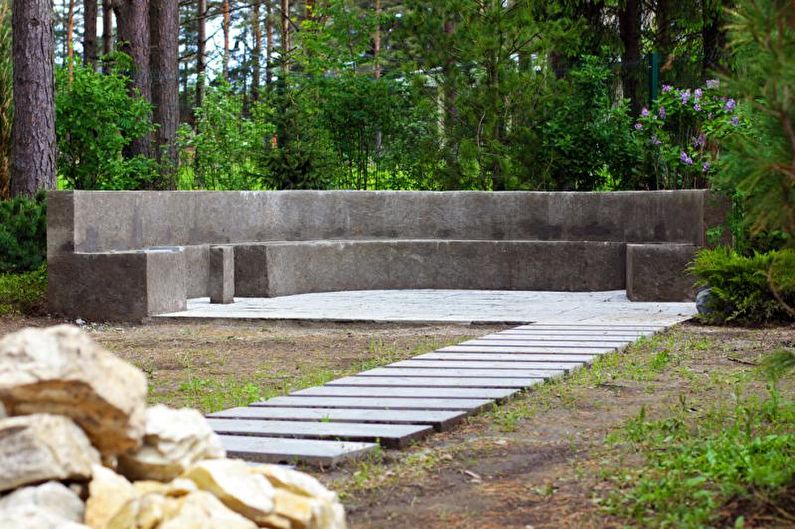
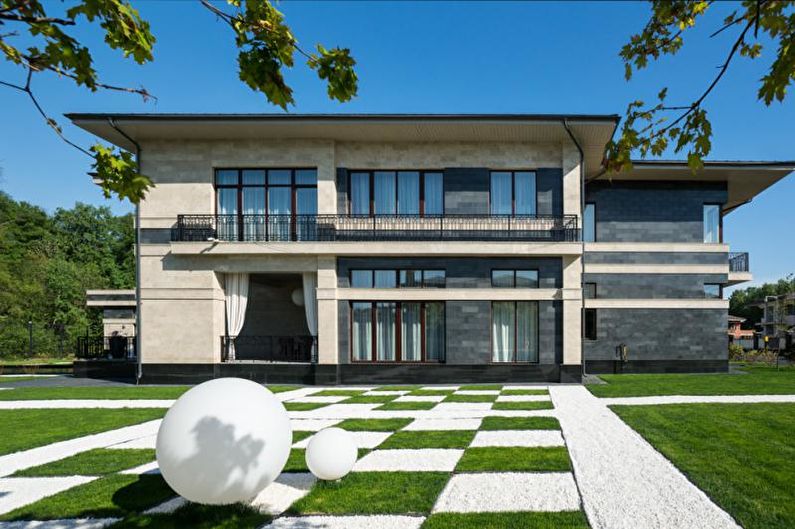
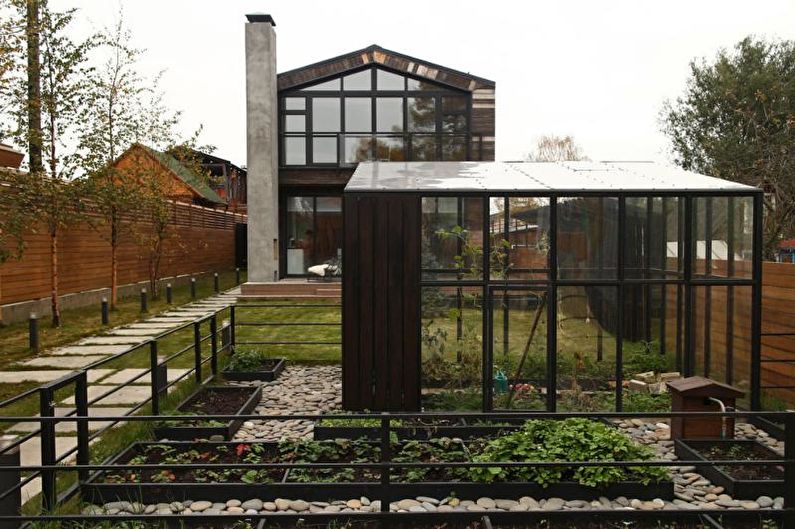

Green spaces
To start landscaping, you need to draw up a plan and determine the varieties of plants for planting and their location. In this situation, it is best to use the traditional zone division algorithm:
- The outer side is a fence, the role of which can be a fence or hedge;
- Internal - located directly near the main building;
- Intermediate - places for rest and accessible to the eye areas that need to be ennobled.
As for the outer part, it can be landscaped at will. Install a beautiful fence and gate, and then complete the fence with a hedge along the entire plane or in part. The vegetation for the fence is different: fruit trees or shrubs in one or two lines. Tall trees are planted in one row, it can be: cedar, fir, pine, plum, mulberry or apple tree.
For a two-row planting, select the bushes: rose, currant, lilac. You can also arrange vertical gardening, hang flower pots on the fence, or plant weaving plants near it. Such vegetation will provide an excellent aesthetic appearance and an incomparable smell.
For the territory near the house, plant stunted bushes or arrange a neat flower bed. The flower garden border, mono flower garden or mixborder organically looks in this area. Mark the borders and regularly look after the flowers - and you will create a cheerful image of your porch.
The intermediate zone is the most important and time-consuming. Place a lawn over the entire area. Further, it all depends on your plans. For example, combine lush green grass with an alpine slide or rockery. Designs in the form of a swing, arbors, pergolas can be transformed by ivy or bindweed. For this zone, all types of flower beds will be appropriate, it is only important to combine them correctly with the rest of the design details. Decorate the site with original flower beds: multidimensional, in the shape of a stream, on elevations, in drawers, baskets, old boots, logs and so on.
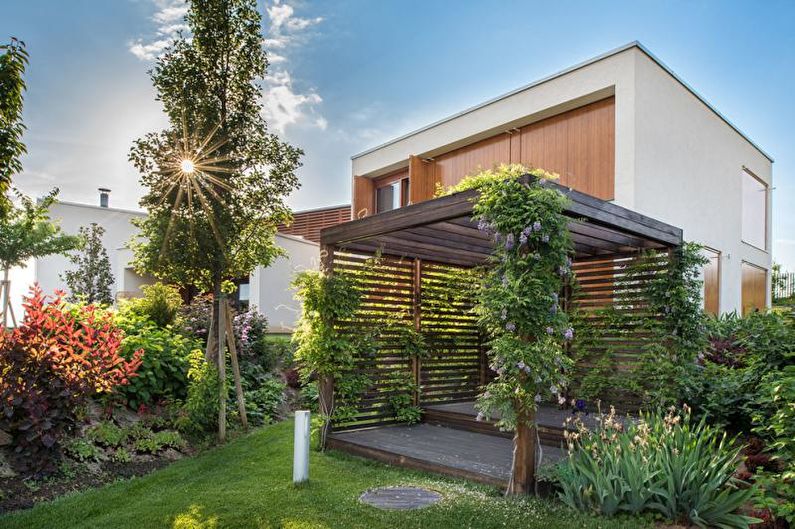
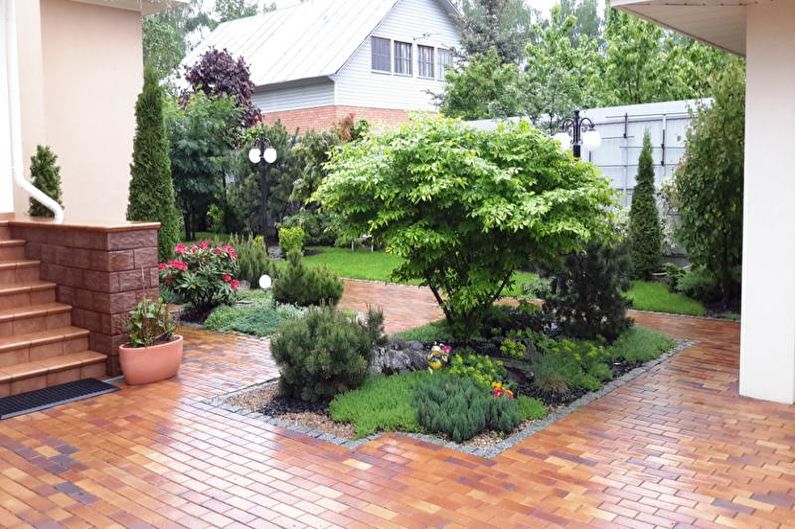
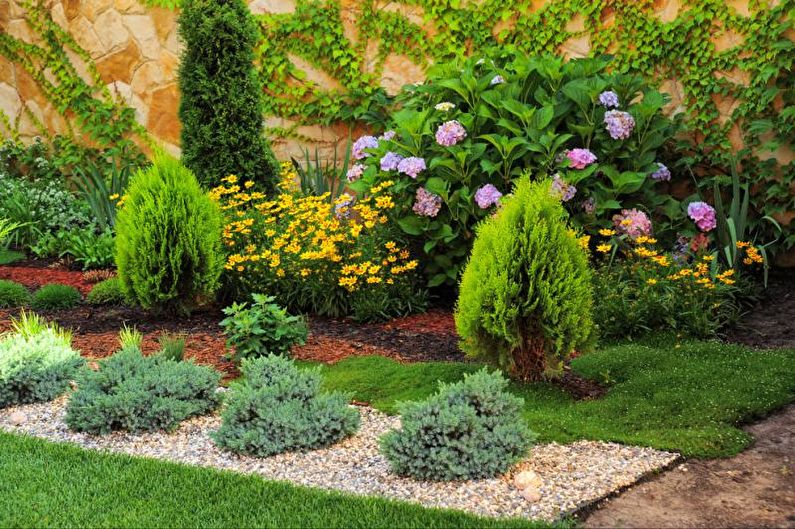
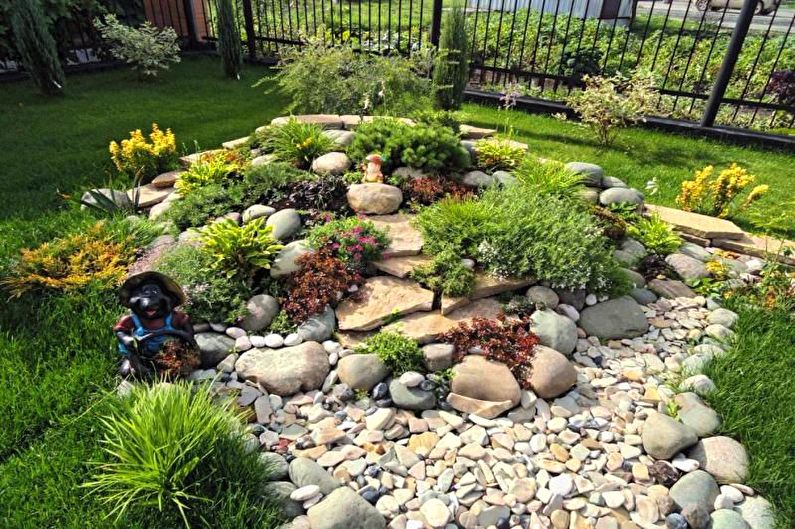
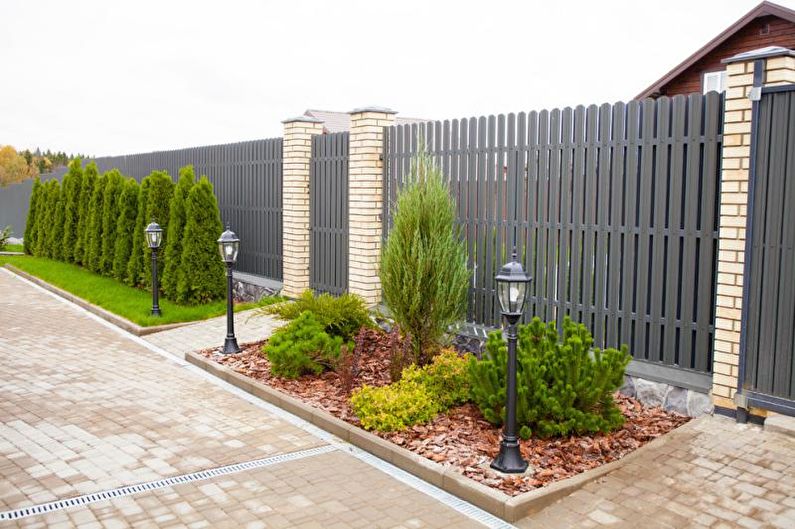
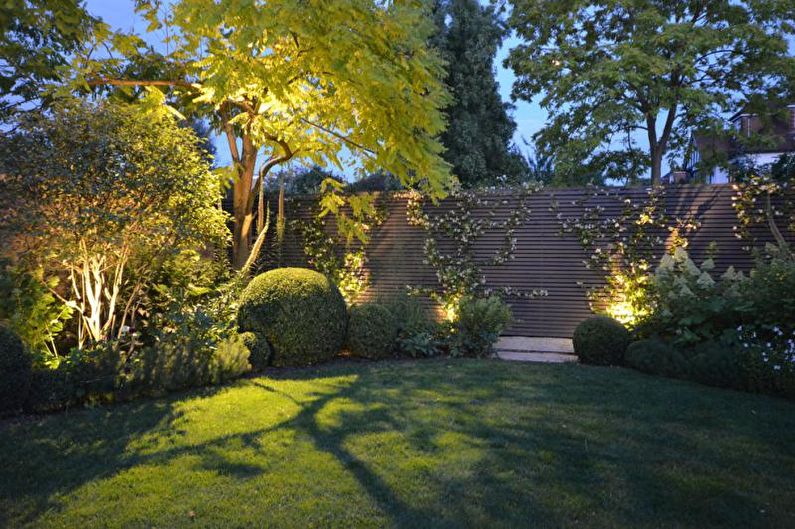
Ponds
Ponds have deservedly settled on one of the main positions in landscape decoration, emphasizing the features and perception of space, as well as filling it with functionality. Modern design offers many different variations of ponds that you can pay attention to when planning: a fountain, a pool, a stream, a pond (classic, landscape), a garden aquarium, a mini-pond in any capacity (you can do it yourself), multi-level (including streams and waterfalls).
When choosing the type of pond, start from its functions, as well as the general concept of your summer residence. Before planning, you should look at the natural landscapes. Use them to create artificial ponds - it will look as natural and harmonious as possible.
Shape and size can be absolutely any. Determining these parameters, you need to take into account the style of the entire garden, the location of the water area and functional purpose.
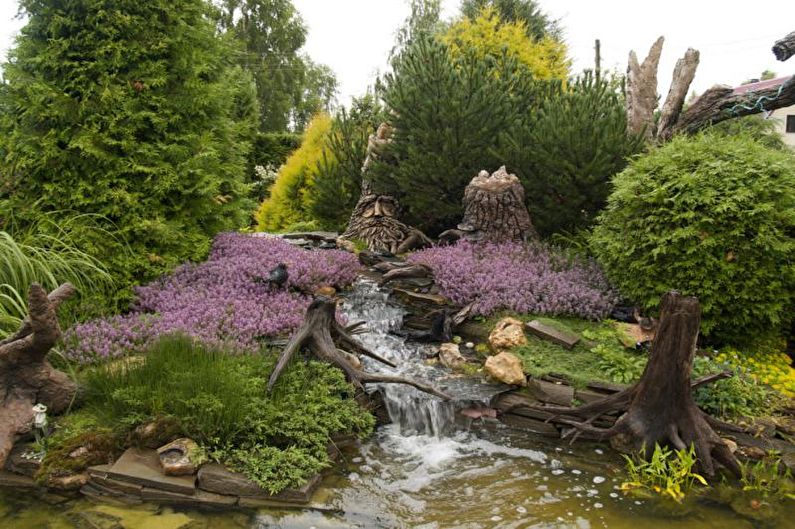
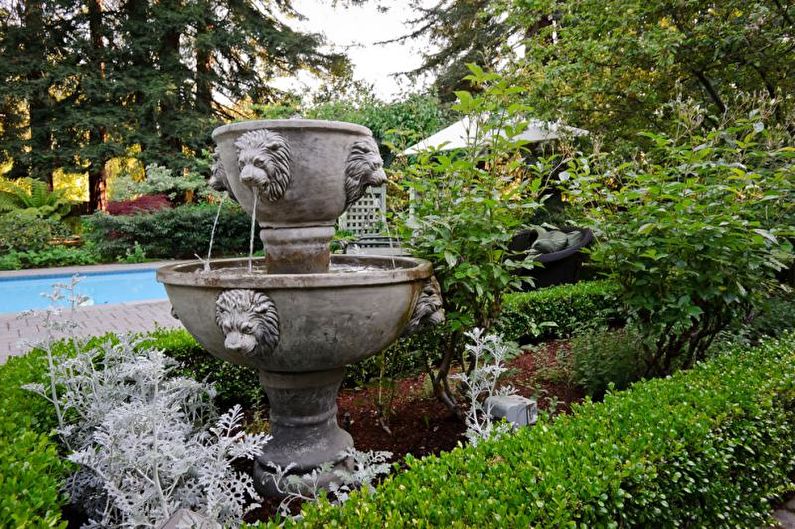
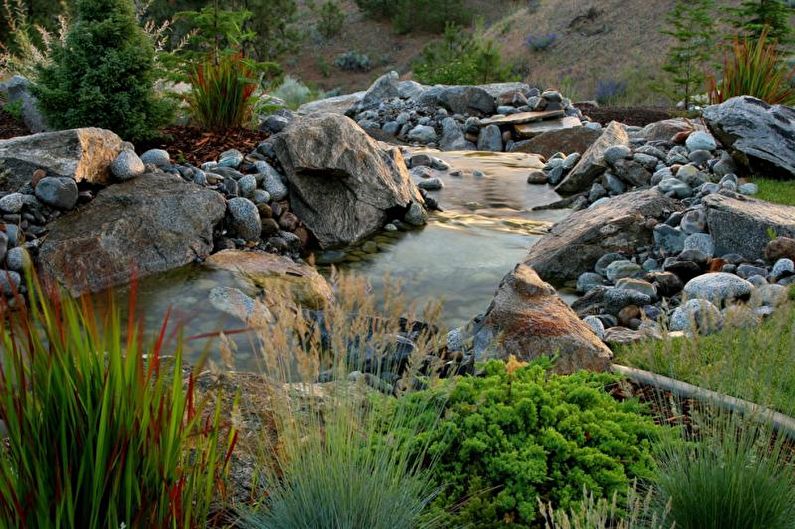
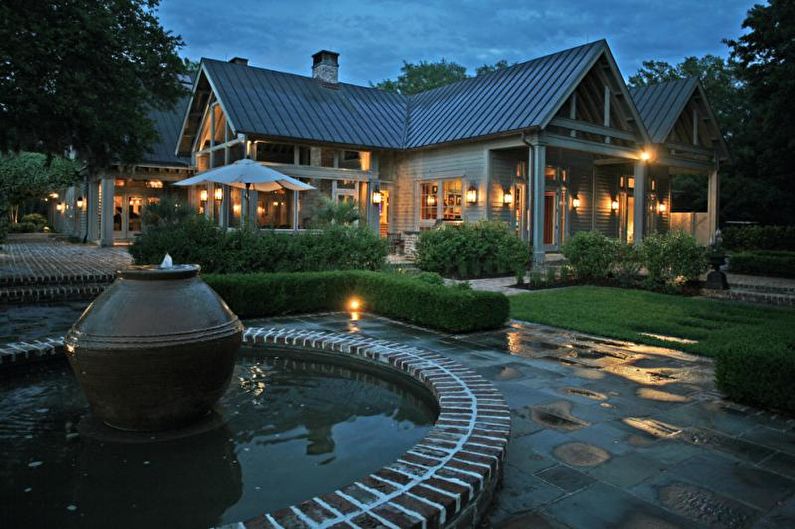
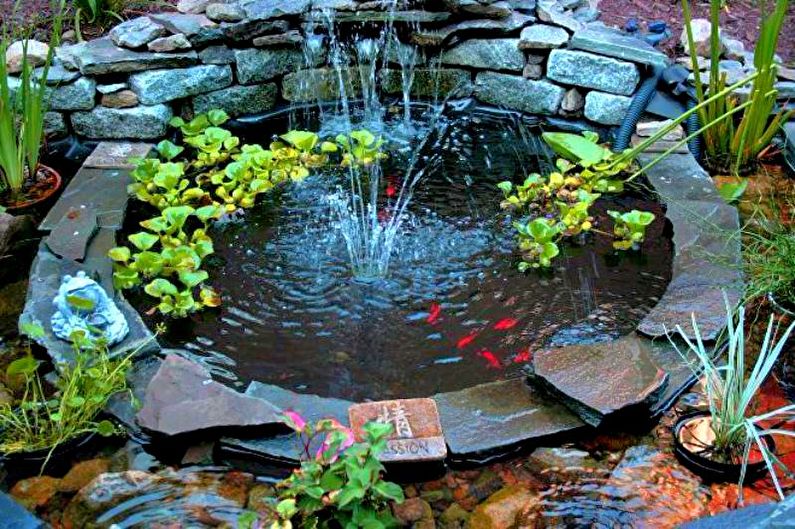
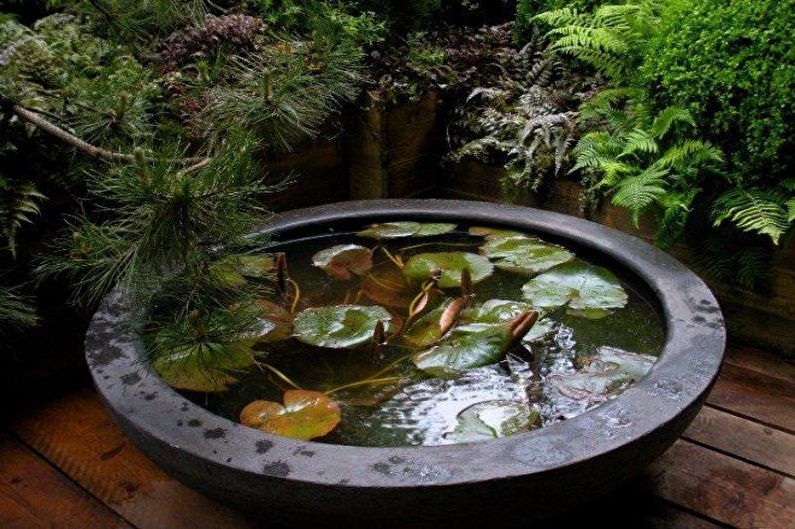
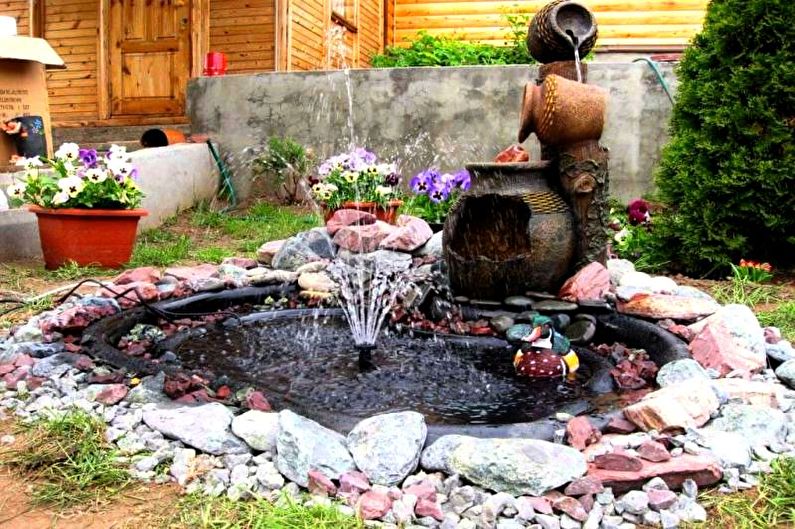
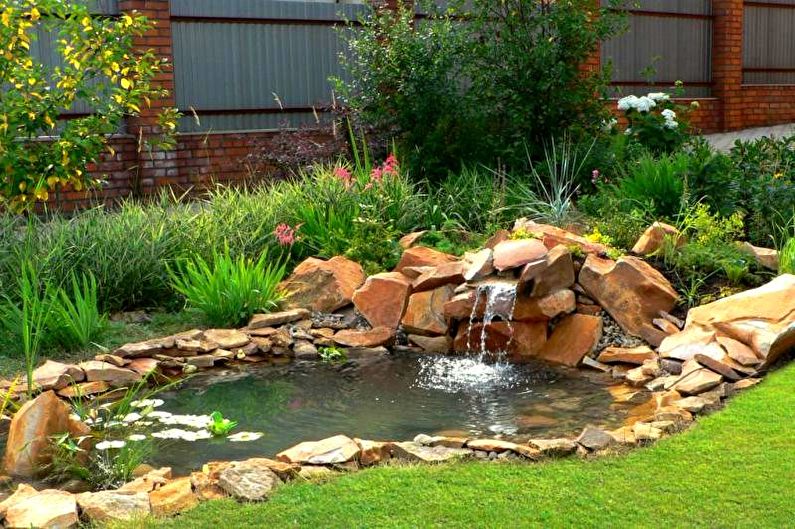
Track
Garden paths are a necessary part of the modern design of the courtyard of a private house. Despite the fact that the main function of the paths is to create safe conditions for moving around your site, they also give the opportunity to zon and decorate the yard area. Garden paths can be made of a variety of materials, such as large flat stones, various bricks, fine gravel or concrete slabs. By combining materials, fencing paths with small borders or decorating them with additional elements, you can achieve not only the desired functionality, but also the decoration of the territory.
Depending on the desires of the owner and the general concept, certain geometric shapes can be used. Straight or winding paths in the company of rectangular or oval flower beds will create a unique image of space.
Sometimes private ownership does not have a perfectly flat surface, but hills and pits. Do not fight with nature and level the site, it is best to succumb to its will and combine paths with steps. This diversifies the paths connecting the zones of your estate.
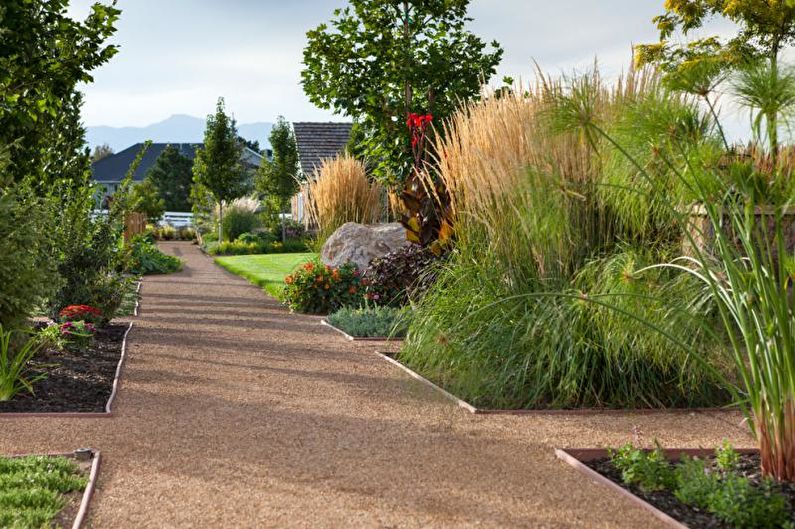
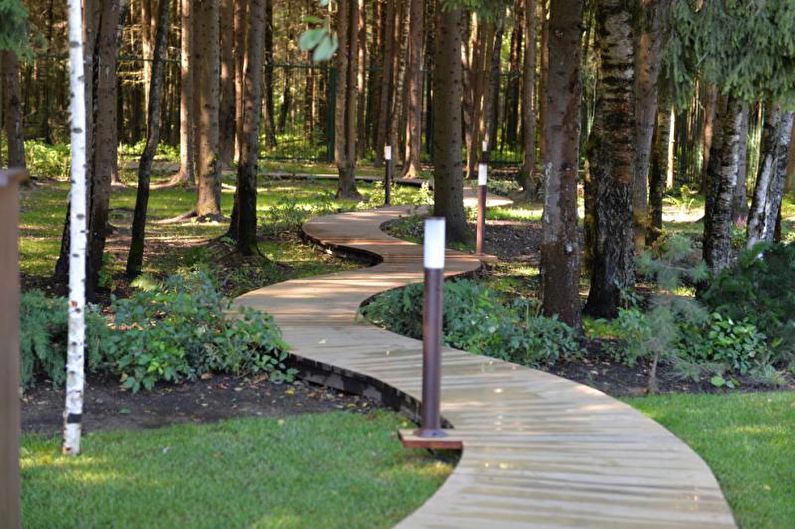
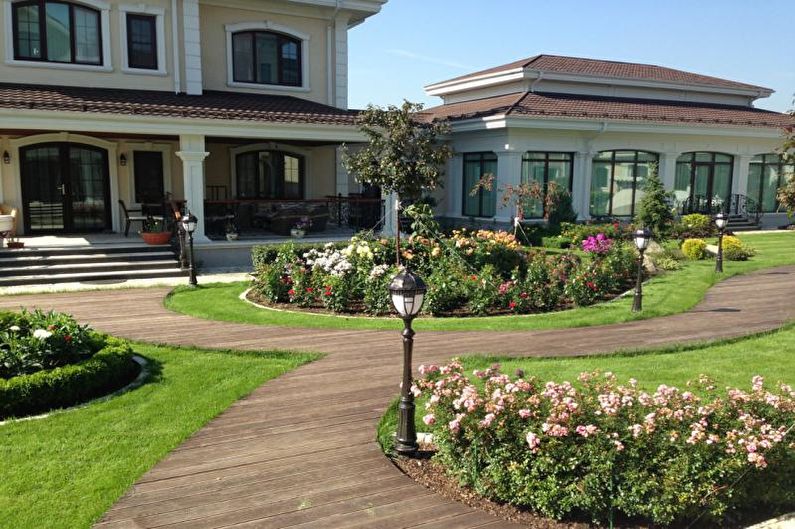
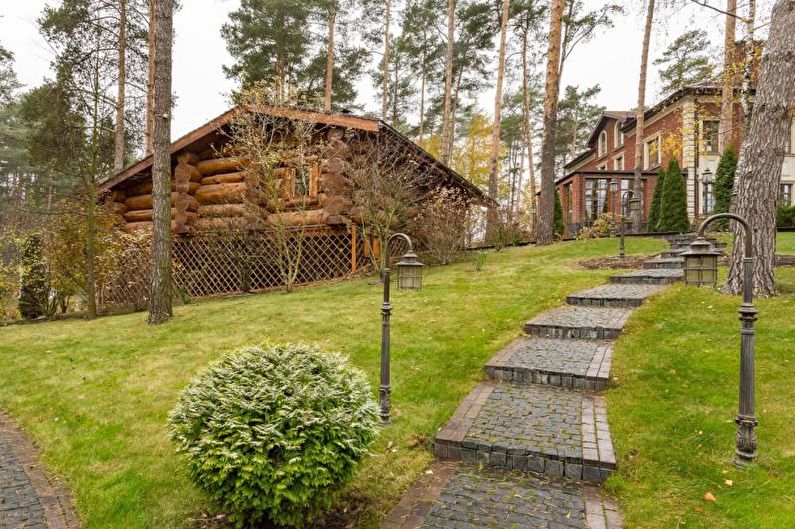

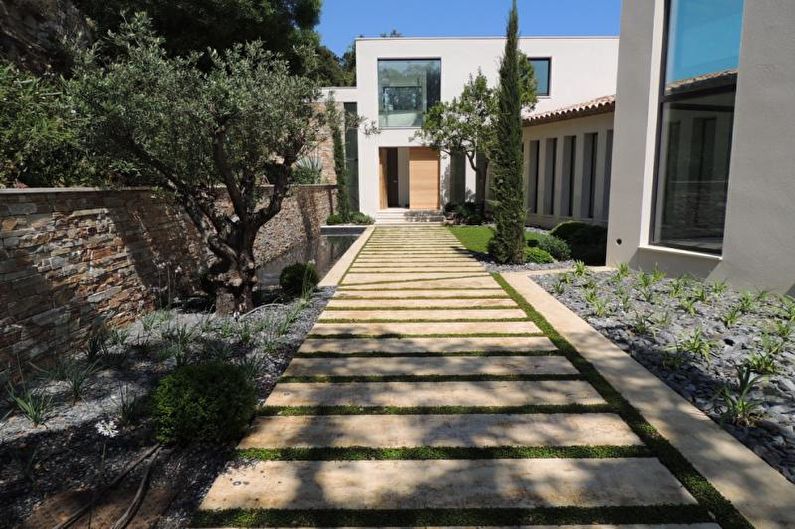
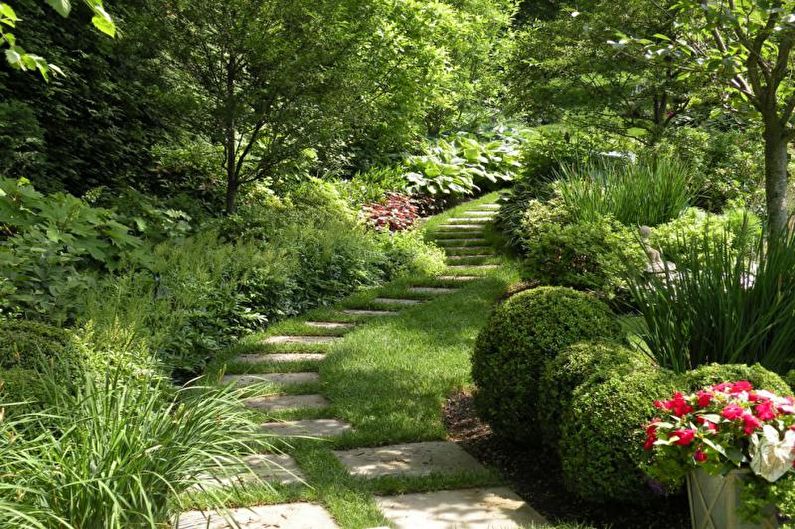
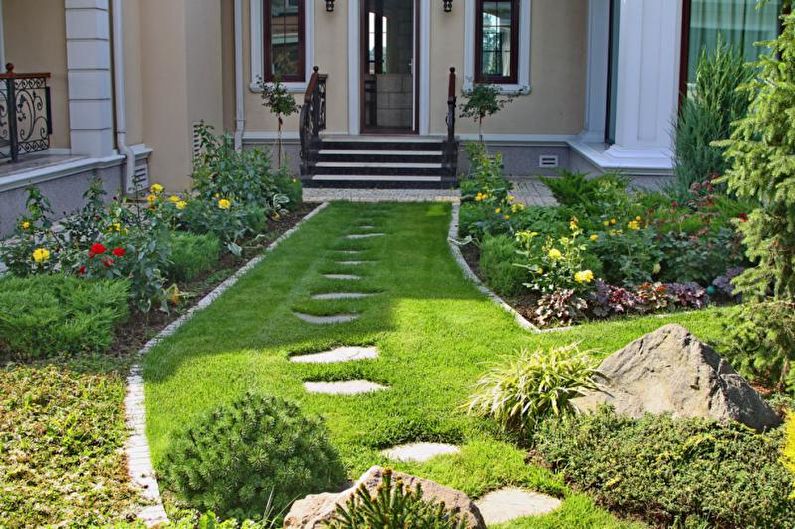
Additional buildings
Landscaping involves the creation of building structures for outdoor recreation:
1. Pergolas allow you to organize beautiful flower arches, easy protection from the sun and wind by the pool and at the dining table, as well as zoning the space. It can be arched structures, peaks at the main building, separately standing structures.
2. Everyone is familiar with the functional purpose of the gazebo, while it can be embodied in a variety of configurations: open or closed, braided by vegetation, located separately or adjacent to the house. Pergolas are created in classic, oriental, forest and rustic styles. There are also exclusive options with swing seats, in the form of a ship, a huge teapot, a needle with an opening at the top for smoke from a fire, and so on.
3. The swing will please both very young and adult owners of private households. Be creative and place swing sofas, hanging beds, benches, chairs or a round swing with a mattress in the garden.
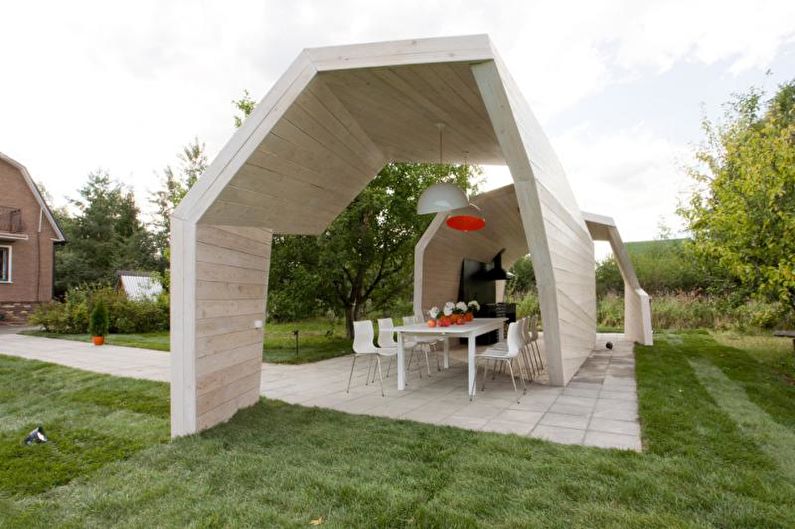
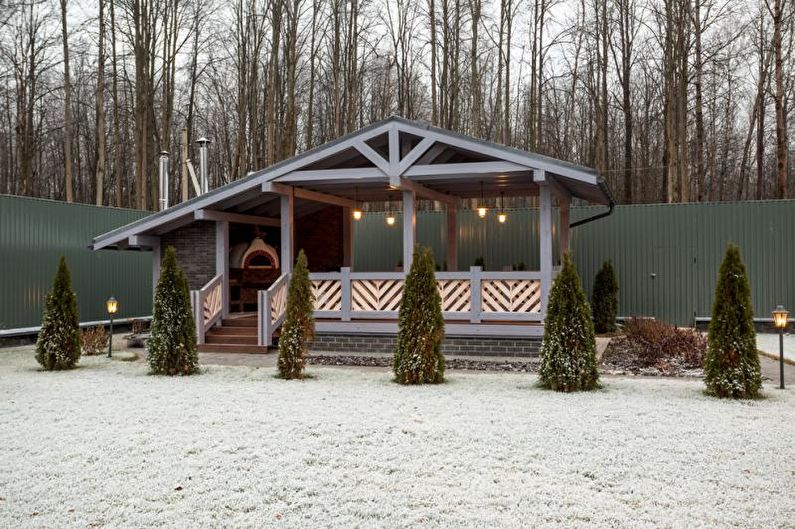
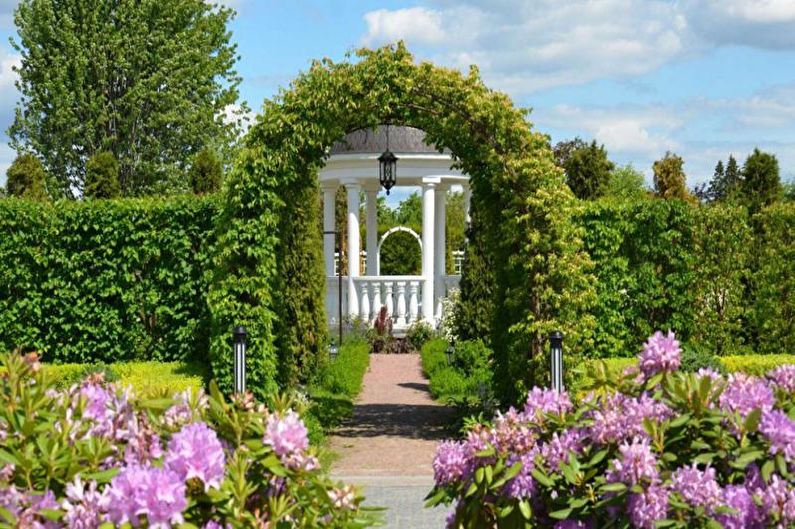

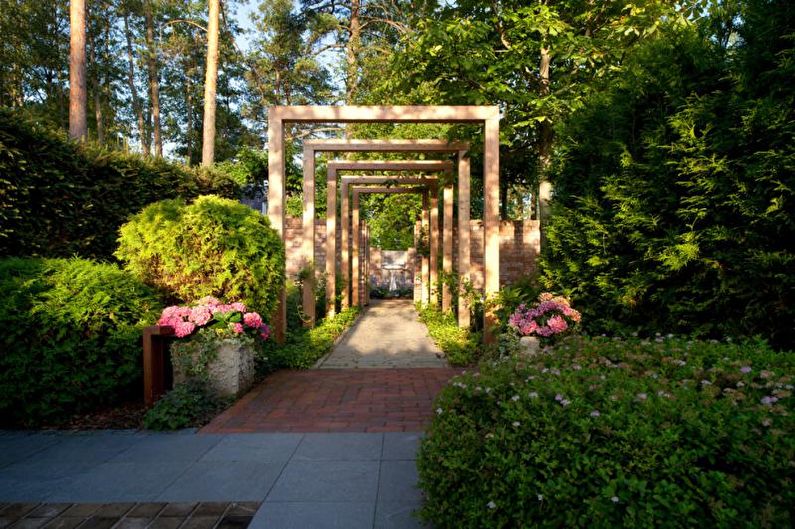
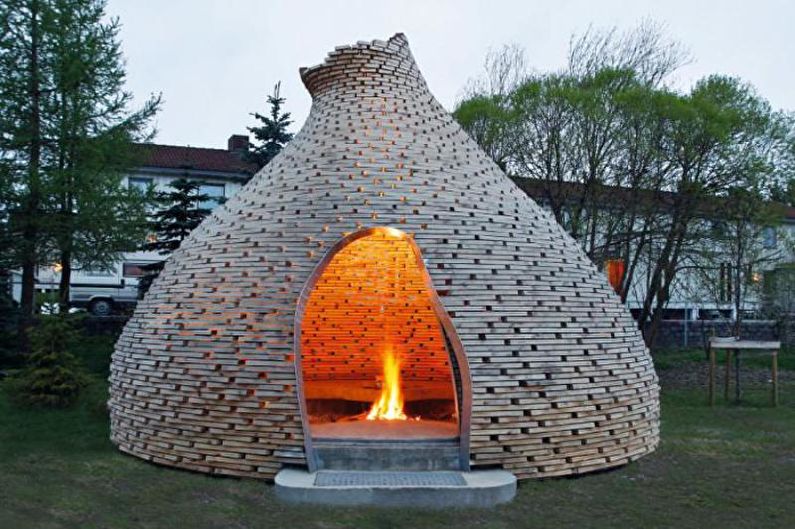
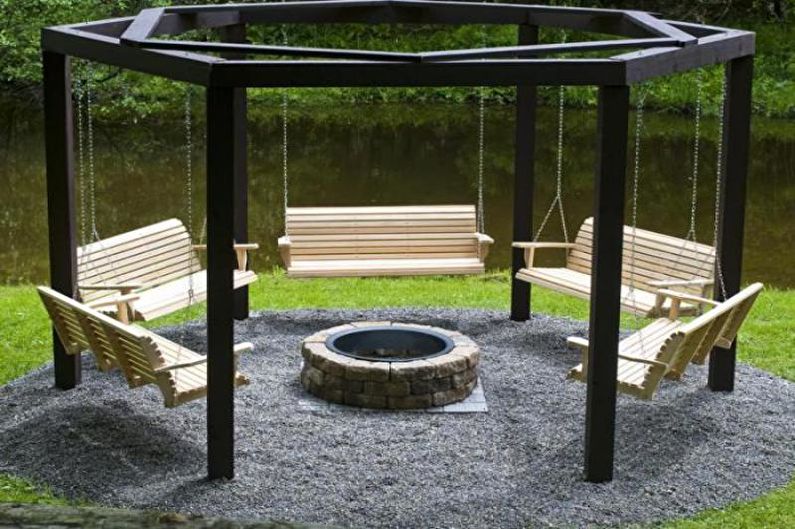
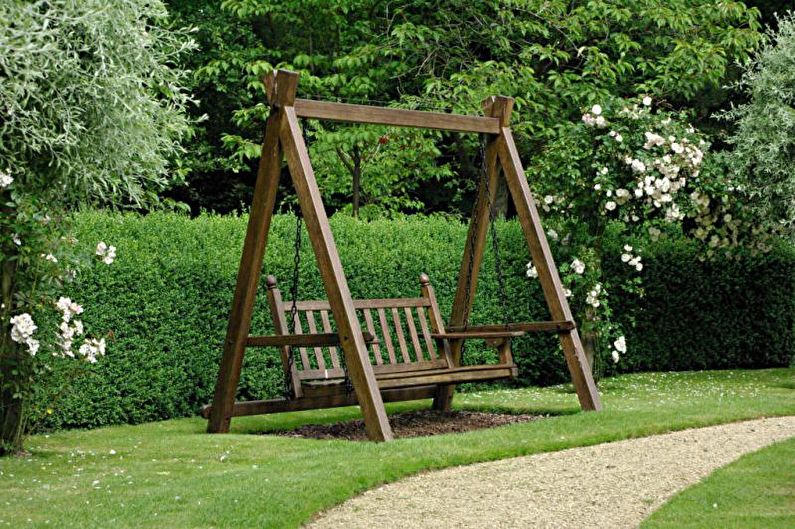
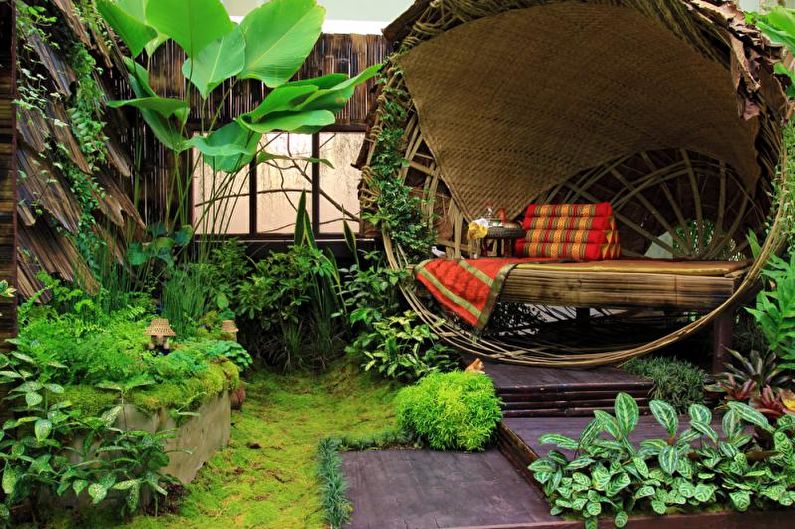
Lighting
Lighting the site is a simple task, you just have to arm yourself with hard work and patience. The correct approach to the installation of fixtures will emphasize the necessary zones and hide unpretentious locations. Lighting will give the design a completely new look, color the structure of your home, and the surrounding area will come to life and will sparkle with warmth and hospitality.
Please note - you do not need to fill the entire area with bright light, this will not give comfort, but, on the contrary, will reduce it and hit your budget. The main lighting always focuses on both the structure and the main elements of the site. The backlighting is organized from top to bottom, from bottom to top, paths, ponds are highlighted, it can be counter-current (to create shadows) and spot.
You can purchase glass, plastic or metal lamps in construction stores, as well as create exclusive options on your own: cans or flashlights with LEDs; devices from clothespins, cans; bottles with lamps inside; mini-sculptures made of wood holding lighting structures; crafts from small logs; fairy lights; hanging jars with candles.
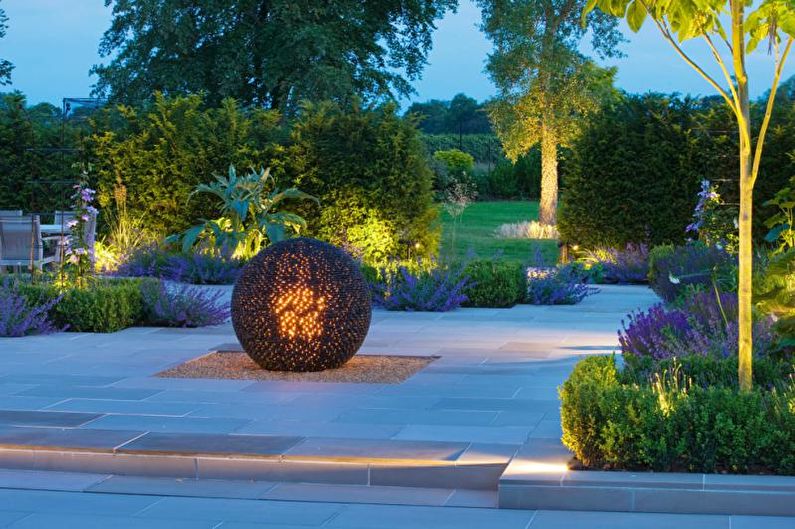
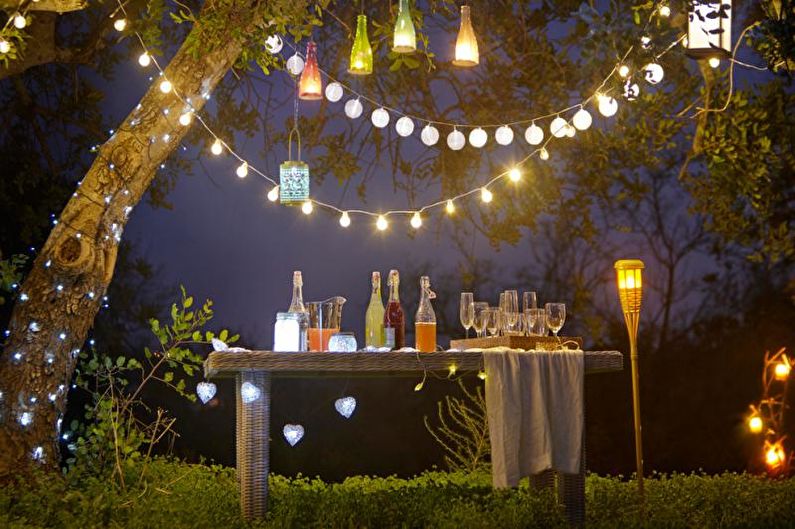
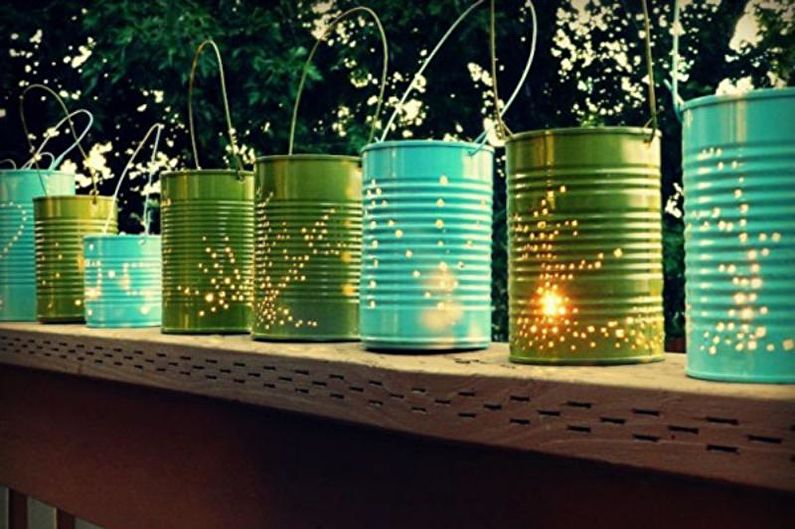
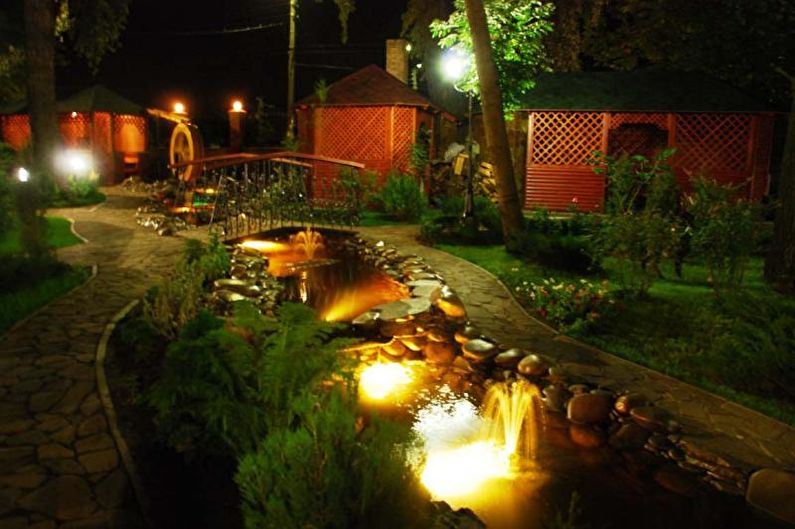

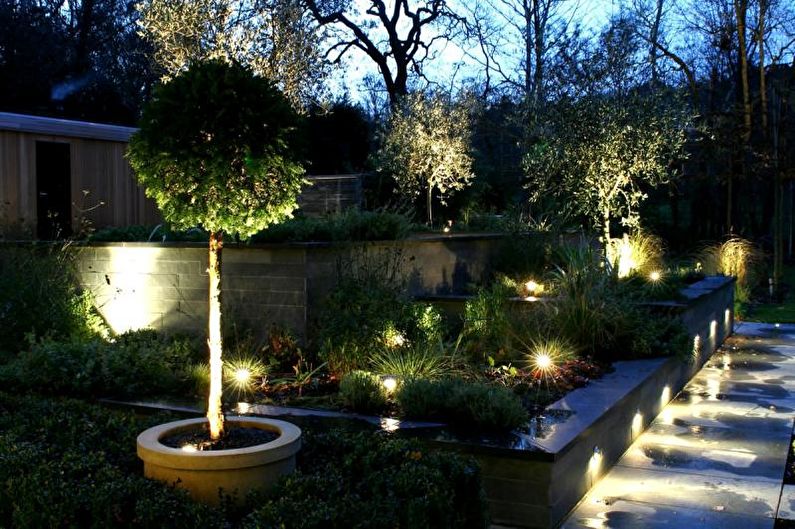
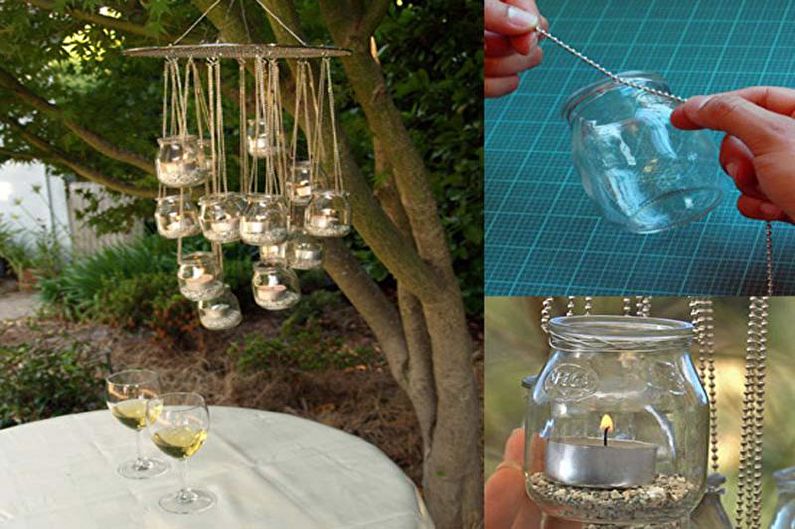
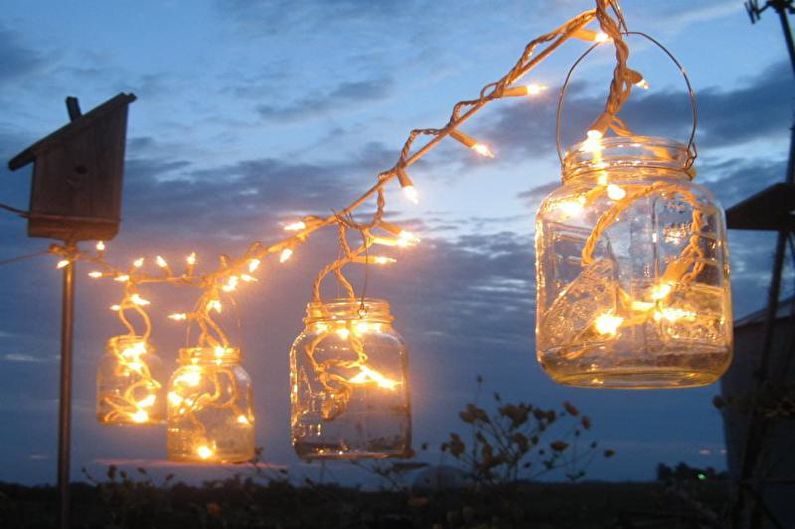
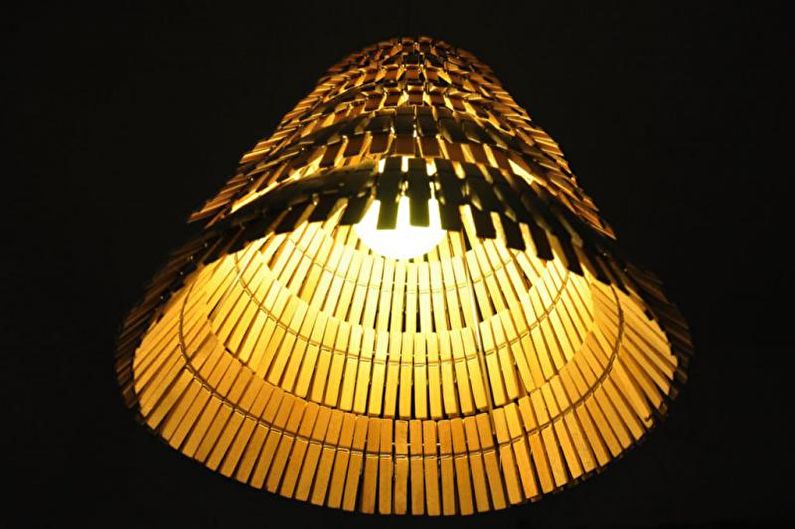
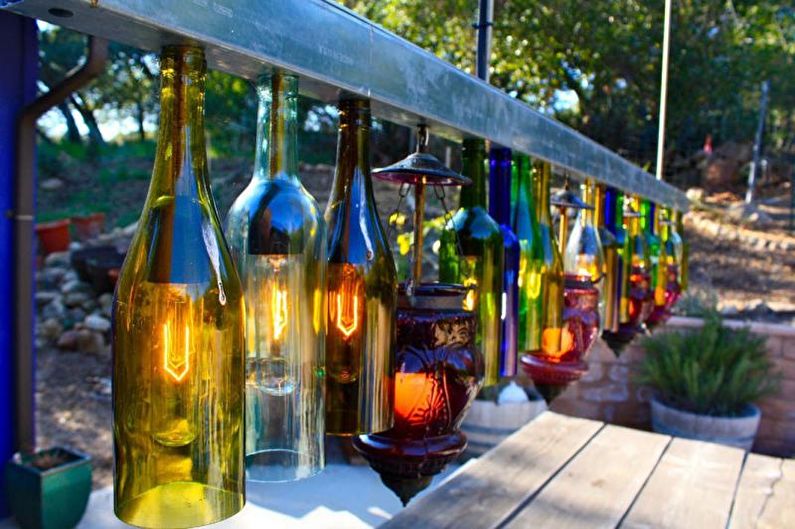
Video: DIY cottage design

